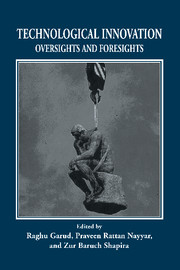Book contents
- Frontmatter
- Contents
- Contributors
- Foreword
- Preface
- Section I Introduction
- Section II Learning to flip coins
- Section III Tailoring fits
- Section IV Remembering to forget
- Section V (S)Top management and culture
- 13 Firm capabilities and managerial decision making: A theory of innovation biases
- 14 Organization responsiveness to environmental shock as an indicator of organizational foresight and oversight: The role of executive team characteristics and organizational context
- 15 Technological innovation, learning, and leadership
- 16 Risky lessons: Conditions for organizational learning
- 17 Exploiting enthusiasm: A case study of applied theories of innovation
- Section VI Clearing the fog
- Author Index
- Subject Index
16 - Risky lessons: Conditions for organizational learning
Published online by Cambridge University Press: 07 October 2011
- Frontmatter
- Contents
- Contributors
- Foreword
- Preface
- Section I Introduction
- Section II Learning to flip coins
- Section III Tailoring fits
- Section IV Remembering to forget
- Section V (S)Top management and culture
- 13 Firm capabilities and managerial decision making: A theory of innovation biases
- 14 Organization responsiveness to environmental shock as an indicator of organizational foresight and oversight: The role of executive team characteristics and organizational context
- 15 Technological innovation, learning, and leadership
- 16 Risky lessons: Conditions for organizational learning
- 17 Exploiting enthusiasm: A case study of applied theories of innovation
- Section VI Clearing the fog
- Author Index
- Subject Index
Summary
Introduction
For both individuals and organizations, most behavior is habitual. In a given situation, people do what they have usually done. When their behavior changes, it is often gradual, as behavior patterns are shaped by the feedback that they evoke. Producing good outcomes increases a behaviors' chance of being performed again, whereas unpleasant outcomes increase the search for alternative behaviors. Learning may be defined as appropriate change or consistency (Levitt & March, 1988).
The learning process involves a series of decisions, where one option is business as usual and the other options constitute changes – either innovations or reversion to earlier behavior. Whenever learning is possible, each option must be evaluated in terms of the outcomes it can cause and the lessons it can teach. For example, a short-term loss might be weighed against the chance to learn something generally useful (e.g., passing up a favorite watering hole in order to try a new restaurant, pulling one's best sales rep off solid accounts in order to test a new territory) (Einhorn, 1986).
Decision theory provides a set of well-articulated analytical methods for making such choices (Kleindorfer, Hershey, & Kunreuther, 1992; Raiffa, 1968; Watson & Buede, 1986; von Winterfeldt & Edwards, 1986). It can incorporate both an action's direct impacts and its informational value. The value of information can be both instrumental (through improving future decisions) and intrinsic (through satisfying curiosity, reducing the aversive-ness of uncertainty, or providing the “thrill value” of trying something different).
- Type
- Chapter
- Information
- Technological InnovationOversights and Foresights, pp. 306 - 324Publisher: Cambridge University PressPrint publication year: 1997

